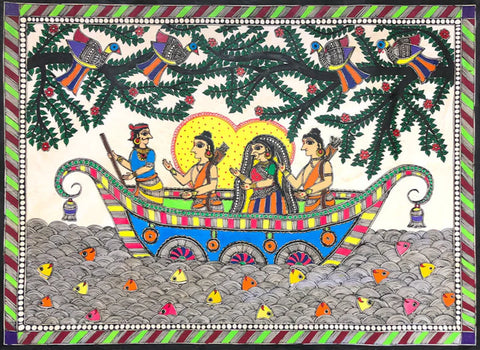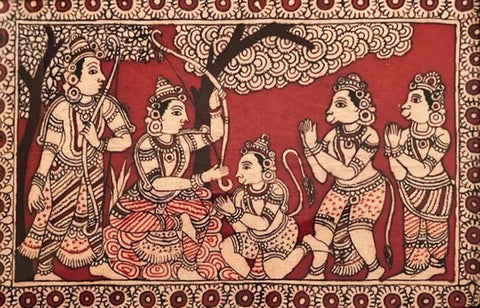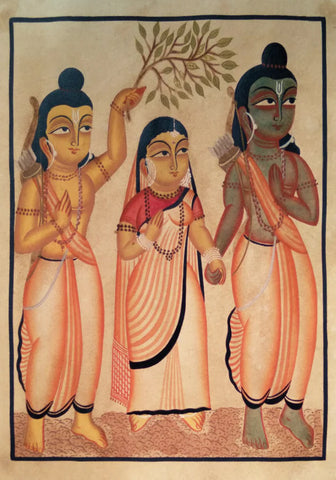The ancient Indian epic, Ramayana, continues to resonate through the ages, its moral lessons still relevant today, influencing generations to come. Written by sage Valmiki, it is a saga of love, loyalty, and righteousness. The Ramayana has not only been an indispensable part of the cultural fabric but has also found expression in various artistic forms of the country. Let’s embark on a visual journey through the lens of traditional and folk arts, exploring how distinct traditions like Madhubani, Tikuli, Kalamkari, and Kalighat breathe life into the timeless episodes of the Ramayana.
Tikuli
Tikuli refers to Bindi or a dot worn on a woman’s forehead as adornment. It finds its origin in Bihar, the land of Tikuli, and dates back approximately 800 years. Its appreciation by the Mughals led to its mass appeal and popularity. Practised in a different form today, it is a way of life and earning for many artisans in Bihar.
The major themes of Tikuli revolve around the local festivals, weddings, and stories from the Hindu pantheon. Being the land of Devi Sita, Ramayana is one of the most commonly depicted themes in Tikuli, depicted with meticulous craftsmanship.
One of the most distinctive features of Tikuli is its focus on storytelling within a confined space. Artists skillfully capture the essence of Ramayana episodes, employing fine lines and intricate detailing to convey emotions, drama, and the underlying moral teachings of the epic. The characters, adorned in vibrant attire, reflect the cultural nuances of the region, adding a unique flavour to the portrayal.
The colour palette used in Tikuli often comprises rich reds and vibrant blues creating a symphony that enhances the emotional essence of the depictions. This meticulous choice of colours not only adds to the aesthetic appeal but also reflects the cultural context and traditional preferences of the art form.

Tilkuli art
This painting by Ashok Kumar depicts the beautiful scene of Ram Darbar in a typical Tikuli style. It is the scene representing the return and coronation of the rightful king of Ayodhya, Ram, along with his wife, Sita. They are surrounded by the three sons of Dashrath - Bharat, Lakshman, and Shatrugan, along with Shri Ram’s ardent devotee - Hanuman. This painting is a depiction of love, friendship, and companionship.
Tikuli takes care of all the intricate details and depicts them in a stylised folk style,with big eyes, intricate designs, multiple shades of colours, vibrant hues, and meticulous use of motifs like sun, tree, etc. It focuses on the characters of the story by painting the expressions and bodily movements.
Madhubani
Madhubani, also known as Mithila, is one of the most renowned art of Bihar. It is a centuries old tradition that captures the essence of cultural narratives of the region, including the illustrious epic, Ramayana. According to local traditions, it was Raja Janak who commissioned the first Madhubani paintings in the entire town of Mithila to commemorate the wedding of his daughters to the princes of Ayodhya. With its roots in the wedding of Shri Ram and his consort Devi Sita, the art is passed down from generation to generation, each element carrying a story in itself. The Ramayana is one of the most sacred texts in the Mithila region (encompassing regions of present day Bihar and Nepal.) Even today, a form of Madhubani painting - the Kohbar, is beautifully depicted during weddings.
The Madhubani paintings are made using bold strokes and vibrant colours along with symbols and elements of fertility, prosperity and good-luck. Each painting becomes a visual representation, unfolding different stories. The bright hues and shades are sourced naturally from plant products like sandalwood, cow dung, soot, rice powder, marigolds, and other flowers. The elements are often outlined with double-lines, and the characters are depicted with bulging fish shaped eyes and pointed nose. The faces are often painted in profile, and are rarely painted with a front-view.

Madhubani art
This painting by Ambika Devi depicts the initial journey of Shri Ram, Sita and Lakshman to the forest after their exile. Embarking on a boat in the Ganges river, it depicts a period of physical and spiritual transcendence and liminality that they had to endure before they fully incorporated into the life of a Sanyasi, or a hermit.
The boat symbolises the challenges and obstacles that Ram, Sita, and Lakshman will face in the forest, and is also a metaphor for their soul's spiritual quest for enlightenment at that time. The water on which the boat floats also signifies the purity, spirituality, flow of life, and the character's destinies that lay ahead.
Both Lakshman and the boatman represent their immense devotion and respect towards Ram and Sita, as the former accompanies them Lord Ram and Sita to the forest while the latter renders his services to take them to the forest.
Kalamkari
Originating in the state of Andhra Pradesh, Kalamkari is a beautiful amalgamation of storytelling and intricate craftsmanship. It is done in two different styles - Srikalahasti and Machilipatnam, even though the end result remains the same. The Srikalahasti style uses a qalam, or a pen for freehand drawing and painting, whereas the Machilipatnam style uses wooden blocks to trace the basic structure, followed by the use of qalam, or pen to make the intricate details in the painting.
The major themes of the Kalamkari paintings are from Hindu mythology, such as episodes from the different Epics and Puranas. The Kalamkari paintings are made using flowing lines and vivid details on the figures, their attire, jewellery, background and the borders. The colour palette is predominantly natural, with earthy tones derived from the plant-based dyes. Each colour serves as a conduit for expressing specific emotions or establishing the thematic ambience within the painting.

Kalamkari Art
The painting by renowned Kalamkari artist Siva Reddy depicts the scene from Ramayana when Lord Hanuman meets Lord Ram for the first time. It depicts Lord Ram and Lakshman, armed with their bows and arrows sitting calmly in the forest. While Lord Hanuman is depicted in a worshipping stance along with his two companions.
The intricate detailing in their attire and expressions reveals a deep connection and mutual respect between the two divine beings. Through the delicate strokes of the qalam and the infusion of vibrant colours, the artist creates a visual symphony that transcends time, inviting audiences to immerse themselves in the eternal tales of Siya- Ram, and the epic journey of righteousness.
Kalighat
Kalighat Paintings originated in the land of Kolkata and are known for their minimalistic yet impactful storytelling. Kalighat art has strong ties to religious themes, often depicting scenes from Hindu mythology, along with scenes of local folklore and satire. The Ramayana, as a revered epic, is portrayed with a sense of devotion, capturing the divine nature of its characters. Kalighat artists infuse religious imagery with a touch of accessibility, making the epic relatable to a broader audience.
The Kalighat art form uses all kinds of natural colours and tones - vibrant and muted. The element of shading added to each element of the painting gives it a theatrical feel. They can be characterised by their swift and bold brush strokes, exaggerated yet mundane expressions, big almond-shaped eyes, and intricate detailing in the attire or the white-coloured jewellery.

Kalighat art
The painting by Bapi Chitrakar portrays the timeless and revered characters from the Hindu epic Ramayana. The artwork beautifully portrays Lord Rama, Sita, and Laxman in exile, evoking the spiritual and cultural richness of their story. Lord Rama, the embodiment of virtue and dharma, is depicted with his bow and arrow, symbolising his readiness to uphold righteousness. He radiates a sense of noble authority, signifying his role as a divine hero. Sita, the epitome of grace and devotion, stands beside Rama, her countenance reflecting her unwavering commitment to her beloved husband. Her presence adds a touch of serenity to the scene, emphasising the deep love between them. Laxman, the loyal and ever-watchful brother, stands beside them, ready to serve and protect. His unwavering devotion and vigilance are evident in his posture and expression.
Folk arts, rooted in tradition and steeped in cultural narratives, serve as compelling mediums for storytelling. Every stroke of the brush, every carefully crafted line, and every vibrant hue within these artistic expressions contribute to a visual symphony that narrates the enduring tales of Rama, Sita, Hanuman, and the diverse array of characters that populate the epic. Through the brushwork of skilled artisans, the Ramayana comes alive, transcending time and bridging generations, ensuring that its profound messages continue to resonate in the hearts of those who behold these mesmerising folk art representations.
References
Daryani, Khushi. “The Beautiful Arts of Bihar - Manjusha, Tikuli & Madhubani.” Memeraki Retail and Tech Pvt Ltd., February 17, 2021. https://www.memeraki.com/blogs/news/the-beautiful-arts-of-bihar-manjusha-tikuli-madhubani.
Jaswal, Misha. “Kalamkari, Craftsmanship with Bamboo Pens.” Memeraki Retail and Tech Pvt Ltd., January 17, 2022. https://www.memeraki.com/blogs/news/kalamkari-craftsmanship-with-bamboo-pens.
Jaswal, Misha. “Kalighat Paintings.” Memeraki Retail and Tech Pvt Ltd., June 1, 2021. https://www.memeraki.com/blogs/news/kalighat-paintings?_pos=1&_sid=6db4f74af&_ss=r.
Jaswal, Misha. “Madhubani Art: History, Themes and Characteristics.” Memeraki Retail and Tech Pvt Ltd., March 21, 2021. https://www.memeraki.com/blogs/news/madhubani-history-themes-and-characteristics?_pos=34&_sid=f9fc2f583&_ss=r.
Kaur, Jaspreet. “Kalamkari- Timeless Artform of Ancient India.” Memeraki Retail and Tech Pvt Ltd., April 27, 2022. https://www.memeraki.com/blogs/news/kalamkari-timeless-artform-of-ancient-india.
“Tikuli Painting.” Upendra Maharathi Shilp Anusandhan Sansthan. Accessed February 1, 2024. https://umsas.org.in/tikuli-painting-details/.






















